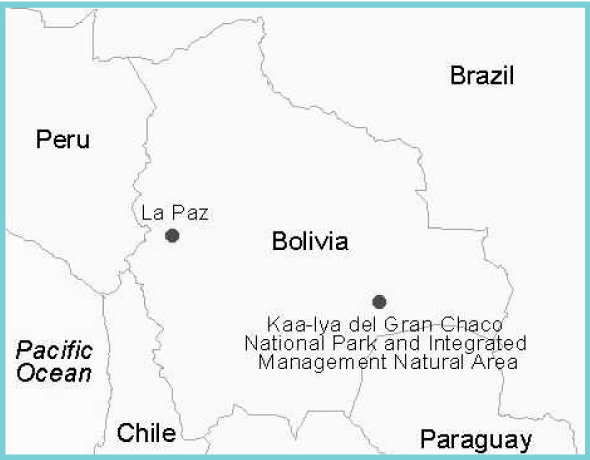 |
The Kaa-Iya del Gran Chaco National Park is the largest protected tropical dry forest in the world, Bolivia’s largest national park at 8.4 million acres, and by some accounts, the largest national park in all of South America.
Known in Spanish as El Parque Nacional y área natural de manejo integrado Kaa-Iya del Gran Chaco, it is also the only park in the Americas established and administered by indigenous people.
Three indigenous peoples, the Izoceño Guaraní, Ayoreode, and Chiquitano inhabit the areas surrounding the park and participate in its management committee. The neotropical park, the most biodiverse and best-preserved area of the Gran Chaco ecoregion, was created through careful planning and dedication by the indigenous peoples through the Capitanía de Alto y Bajo Izozog (CABI), working closely with the Wildlife Conservation Society (WCS). The WCS first partnered with CABI in 1991 when they initially established a protected area there.
The Kaa Iya del Gran Chaco National Park was officially established in September of 1995. Along with the protection of this precious area for its native inhabitants, the primary goal in its establishment was to safeguard the world's largest remaining area of Chaco dry forest, a "habitat type" found in Latin America, which size-wise is second only to the Amazonian rain forest.
WCS supports CABI in the administration of the park as well as “in promoting biodiversity conservation and the sustainable use of those natural resources within the neighboring Isoseño indigenous territory."
The park contains one of the largest diversity of mammals in South America. As Bolivia's most threatened major lowland habitat type, it houses at least 69 species of mammals, serving as a refuge for jaguars, Chacoan peccaries, Chacoan guanacos of which there are only 140 left in Bolivia, giant armadillos, pumas, birds, reptiles, and more.
The park is essentially a dry forest scrubland and receives less than 20 inches of rain each year and temperatures are usually above 90 degrees Fahrenheit. The mammals there have adapted and many can go without water for months at a time, surviving on anything from the juice of a cactus to the water inside their prey.
Perhaps even more unique than the wildlife the park houses is the fact that it puts community-based, grassroots-type conservation into practice. The indigenous people of the area took the initiative to create the park and to manage it. Coming from the humblest of circumstances, they were able to convince Bolivia’s national government to support their project in protecting this large area. This despite the ever-imminent threats of usage of the delicate lands by cattle ranchers, sport hunters, land developers, and more, that still linger on today.
In fact, with the help of WCS, the peoples were even able to negotiate an agreement with the owners of a 1900 mile pipeline, the Bolivia-Brazil pipeline, that passes through the area. A part of the agreement known as the Kaa-Iya Foundation includes a trust fund that helps pay for for the park’s operation. While the resolution is considered controversial by some who feel the pipeline shouldn’t even be allowed in a protected area, WCS says that it “compels the pipeline companies to accept responsibility for the impact of their operations on the local people and lands along the pipeline route."
In 2001, the Bolivian government upgraded protection of two areas within the park by listing them, the Bañados de Izozog, in the Ramsar Convention, an international treaty that safeguards wetlands around the world. The park falls within the National Parks system protected by the Servicio Nacional de Áreas Protegidas (Sernap) (the National Service for Protected Areas).
Also in 2001, CABI was presented with the prestigious "Bartolome de las Casas" award, for “extraordinary efforts in environmental conservation and the protection of indigenous cultures” by Spain’s government. The award, granted by the Secretary of State for International and Iberoamerican Cooperation is a highly coveted international prize and helps the park by bringing attention to its mission, focus, and needs.
By being awarded with this high commendation, the Kaa Iya del Gran Chaco National Park has further proven that a community-based organization can achieve its goals and even garner great international recognition simply through persistance, dedication, and holding tight to a dream.
Page created on 5/3/2013 12:00:00 AM
Last edited 1/5/2017 9:38:37 PM
